
Escambia County is a county located in the south central portion of the U.S. state of Alabama. As of the 2020 census, the population was 36,757. Its county seat is Brewton.

Etowah Indian Mounds (9BR1) are a 54-acre (220,000 m2) archaeological site in Bartow County, Georgia, south of Cartersville. Built and occupied in three phases, from 1000–1550 CE, the prehistoric site is located on the north shore of the Etowah River.

Caborn-Welborn was a precontact and proto-historic North American culture defined by archaeologists as a Late Mississippian cultural manifestation that grew out of – or built upon the demise of – the Angel chiefdom located in present-day southern Indiana. Caborn-Welborn developed around 1400 and seems to have disappeared around 1700 CE. The Caborn-Welborn culture was the last Native American occupation of southern Indiana prior to European contact. It remains unclear which post-contact Native group, if any, are their descendants.
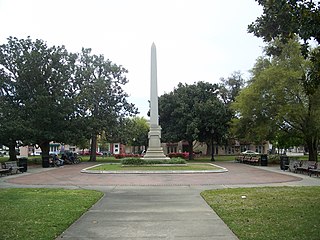
The Plaza Ferdinand VII is an outdoor garden and park in the Historic Pensacola Village area of downtown Pensacola, Florida. It is located on Palafox Street between Government and Zaragoza Streets. It was named after Ferdinand VII of Spain, the King of Spain between 1813 and 1833. A National Historic Landmark, it is the site of the formal transfer of Florida to United States jurisdiction in 1821.
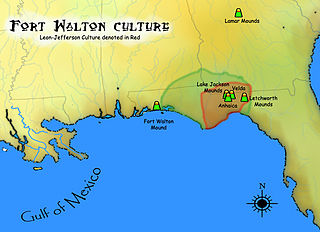
The Fort Walton culture is the term used by archaeologists for a late prehistoric Native American archaeological culture that flourished in southeastern North America from approximately 1200~1500 CE and is associated with the historic Apalachee people.
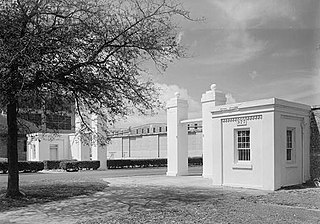
The Pensacola Naval Air Station Historic District encompasses the early historic elements of Naval Air Station Pensacola in Warrington, Florida. Included in the historic district are surviving buildings of the Pensacola Navy Yard, which the air station took over, as well as buildings related to the early years of aviator training by the United States Navy. The district, roughly bounded by West Street, Saufley Avenue, and Pensacola Bay, was designated a U.S. National Historic Landmark District in 1976.

The Fort Walton Mound (8OK6) is an archaeological site located in present-day Fort Walton Beach, Florida, United States. The large platform mound was built about 850 CE by the Pensacola culture, a local form of the Mississippian culture. Because of its significance, the mound was designated a National Historic Landmark in 1964.
The Cayson Mound and Village Site (8CA3) is a prehistoric archaeological site located near Blountstown, Florida. It is located three miles southeast of Blountstown, on the Apalachicola River. The site was occupied by peoples of the Fort Walton Culture. On March 15, 1976, it was added to the U.S. National Register of Historic Places.
The Yon Mound and Village Site (8LI2) is a prehistoric archaeological site located two miles west of Bristol, Florida on the east bank of the Apalachicola River. The site was occupied by peoples of the Fort Walton Culture. On December 15, 1978, it was added to the U.S. National Register of Historic Places as reference number 78000952.
The Waddells Mill Pond Site is an archaeological site located seven miles northwest of Marianna, Florida. On December 15, 1972, it was added to the U.S. National Register of Historic Places.
The Emanuel Point Shipwreck Site is a historic site near Pensacola, Florida, United States. It is located off Emanuel Point. It has been identified as the galleon San Juan, of the fleet that carried conquistador Tristan de Luna and his army to La Florida in 1559. It sank along with most of the fleet during a hurricane that struck the coast shortly after Luna's arrival. On March 4, 1996, it was added to the U.S. National Register of Historic Places.

Escambe was a Spanish Franciscan mission built in the 17th century in the Florida Panhandle, three miles northwest of the present-day town of Tallahassee, Florida. It was part of Spain's effort to colonize the region, and convert the Timucuan and Apalachee Indians to Christianity. The mission lasted until 1704, when it was destroyed by a group of Creek Indians and South Carolinians.
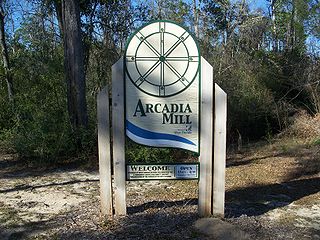
The Arcadia Sawmill and Arcadia Cotton Mill is a historic site a mile southwest of Milton, Florida, United States. On August 3, 1987, it was added to the U.S. National Register of Historic Places.
The Naval Live Oaks Cemetery is a prehistoric cemetery associated with the Pensacola culture, a regional variant of the Mississippian culture. It is located near Gulf Breeze, Florida. On September 28, 1998, it was added to the U.S. National Register of Historic Places.
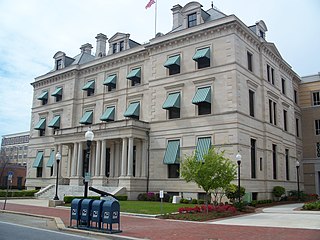
The U.S. Customs House and Post Office, also known as the Escambia County Courthouse, is a historic site in Pensacola, Florida. Built in 1887, it is located at 223 Palafox Place. On July 22, 1997, it was added to the U.S. National Register of Historic Places.
The history of Pensacola, Florida, begins long before the Spanish claimed founding of the modern city in 1698. The area around present-day Pensacola was inhabited by Native American peoples thousands of years before the historical era.

Innerarity Point is an unincorporated community in Escambia County, Florida, United States. It is part of the Pensacola–Ferry Pass–Brent Metropolitan Statistical Area. Innerarity Point is located along Perdido Bay north of Perdido Key.

The Murphy Mound Archeological Site, is a prehistoric archaeological site in the Bootheel region of the U.S. state of Missouri. Located southwest of Caruthersville in Pemiscot County, Missouri the site was occupied by peoples of the Late Mississippian period, centuries before European colonization of the area.

The Pensacola culture was a regional variation of the Mississippian culture along the Gulf Coast of the United States that lasted from 1100 to 1700 CE. The archaeological culture covers an area stretching from a transitional Pensacola/Fort Walton culture zone at Choctawhatchee Bay in Florida to the eastern side of the Mississippi River Delta near Biloxi, Mississippi, with the majority of its sites located along Mobile Bay in the Mobile-Tensaw River Delta. Sites for the culture stretched inland, north into the southern Tombigee and Alabama River valleys, as far as the vicinity of Selma, Alabama.
The Sims site (16SC2), also known as Sims Place site, is an archaeological site located in Saint Charles Parish, Louisiana, near the town of Paradis. The location is a multi-component mound and village complex with platform mounds and extensive midden deposits. The site habitations are divided into three periods. It was first inhabited about 800 CE by peoples of the Coastal Coles Creek culture. By 1100 CE the culture of the site had transitioned into the Mississippianized Plaquemine culture that lasted until 1450 CE. A little later was a Late Mississippian/protohistoric period that lasted from 1500 until about 1700 or 1800.
















